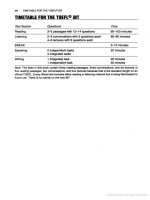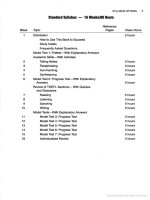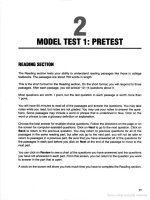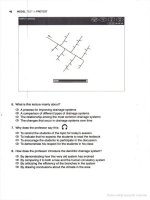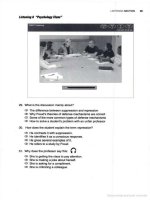Toefl ibt internet based test 2006 - 2007 part 54 ppsx
Bạn đang xem bản rút gọn của tài liệu. Xem và tải ngay bản đầy đủ của tài liệu tại đây (828.89 KB, 7 trang )
3M
MORE
MOO
EL
TE
S
TS
!aI
Sea-level rise must be expressed as a
tIOal
of
values that are under
constant reassessment.
[B]
The
2001 IPCC forecast
lor
global mean sea·level
rise this century. given regional variations, is
fr
om 0.
11-0.88
m.
!Cl
The
median
value
01
0.48 m is two to
lour
limes
the
rate
01
previous increase.
These
increases would continue beyond 2100 even il greenhouse gas concentrations
are stabilized.
IDl
-+
The SGripps InsUlute
of
O<;eanography in La Jolla, California, has kepI
ocean temperature records since 1916. Significant temperature increases are
being recorded to dep,hs
of
more than 300 m as ocean temperature records
are
set. Even the warming
of
the
ocean itself will contribute about
25
% of sea·
level rise, simply
because
of
thermal expansion
01
the water. In addition, any
change in ocean temperature
has
a prolound effect on weather and.
~
~
",
~
octI~
"""
",",,,
and soil moisture.
-+
A quick survey
01
world coastlines shows thai even a moderate rise could
bring
changes
01
unparalleled proportions. At slake are the river deltas, lowland
coastal
farming valleys, and low-lyi
ng
mainland areas, all contending with high
water, high tides, and
higher storm surges. Particularty tragic social and eco-
fIOmic consequences will affect small island states- being able to adjust within
their present country boundaries, disruption
of
biological systems, loss
of
biodi-
versity, reduction in water resources, among the impacts. There could be both
internal and international migration of affected human populations, spread over
decades, as
people move
away
from coastal flooding from the sea-level rise.
1.
The
word confirm in t
he
passage
is
closeSl ln meani
ng
to
<D
clarify
<D prove
<P assume
<D
predict
2.
There is more new plant Iile in Antarctica recently because
<D
the mountain glaciers have melted
<D the land masses have split
into
islands
([)
the icebergs have broken into smaller pieces
(J1) the temperature has risen by a few degrees
3.
II may be inferred from this passage that icebergs are formed
<D
by
a
drop
in
ocean temperatures
<D when
an
Ice shelf breaks free
(J1) from Intensely cold isla
nd
s
II)
if mountain glaciers melt
)pynghlOO
maier I
MOOEl
TEST
5IREADING
SECTION
367
4.
The
WQfd
ttle rB
in
the passage refers
to
<D polar ice
mass
in
the
last
50
years
<D
the
temperature increase
<0
new
vegetation growth
<D
In
the
Antarctic
Pe
ni
nsula
5.
In
paragraph
4,
the
author explains
the
loss
of
polar
and
glacial ice
by
CD
staling
an
educated opinion
CD
referring
to
data in a study
<0
co
mparing
sea
levels worldwide
<lD
presenting h
is
research
Paragraph
4
1s
marked
with
an
arrow
1-+1
.
6.
The
word
conclusive
in
the
passage
is
closest
in
meaning
to
<I>
definite
CD
independent
<0
unique
<D valuable
7.
The
word
mDOflln
the
passage
is
closest
In
meaning
to
CD
function
CD
scale
<D version
<lD
lack
8.
Why
does
the
author menlion
the
Scri
pp
s
In
stitute
of
Oceanography
in
paragraph 61
<D
The
location near
the
coast endangers
the
Scripps facility.
<D
Research
at
Scripps indicates
that
the
ocean
is
getting warmer.
<0
One
quarter of
the
rising sea levels
has
been
recorded
at
Scripps.
<D
A8COfds
al Scripps have
been
kept
for
nearly one hundred years.
Paragraph
61s
m
arked
with
an
arrow I
].
JPyngh
cd
ma
r I
368 MORE MODEL TESTS
9. Which of the sentences belOw best expresses the Information in tile highlighted statement
in
the passage? The other choices change the meaning or leave out important information.
CD
GlObal warming on the surlace of the planet may have been retarded during the last
hundred years because heat in the atmosphere was absorbed by the oceans.
m GlObal warming on the surface of the ocean was greater than
It
was on the rest of the
planet during
the past century because of heat
In
the atmosphere.
<D
Too much heat
in
the atmosphere has caused global warming on the surlace of the
planet
lor
Ihe past hundred years in spite of the moderation caused by
the
oceans.
<D There is less heat being absortled by the oceans
now
than there was a hundred years
ago
before the atmosphere began to experience global warming.
to.
According to paragraph 7,
why
will people move away from the coaslllnes In the future?
CD
1\
w
ill
be too warm for them
to
live there.
m The coastlines will have too much vegetation.
<D
Flood
i
ng
will destroy the coastal areas.
GD
No agricultural crops will be grown on the coasts.
Paragraph
7 is marked with
an
arrow
1-+1
.
11
. Which of the following statements most accurately rellects the author's opinion about ris-
ing sea levels?
<D
Sea levels would rise without global warming.
m Rising sea
1e~ls
can
be
reversed.
<D
The results of rising sea levels will be serious.
GD
Sea levels are riSing because of new glaciers.
12
.
LOOk
at
th
e four squares
1_]lhat
show where the follOwing sentence could be inserted in
the passage.
During
the last century, sea level
rose
10-20
em, a rate 10
times
higher
than the
average rate durh g
the
I.st
3000 y
Where could the sentence best be added?
Ctick on a square
1-)
to Inse,
rt
the sentence in the passage.
lpynght maklr I
MOOEL
TEST
SlREAOING
S£CTION 369
13.
Directions
: An inlroduction for a short summary of lhe passage appears below. Comple
le
the summary
by
selecting the
TH
R
EE
answer choices thai menlion
the
mosl important
poinls In
the
passage. Some sentences
do
nol belong in the summary because they
express ideas that are not
included in the passage
Of
are minor points fr
om
the passage.
Th
is
qUfttlo"
I.
worth 2 pol"ta.
Gl
obal
warming
Is
cau
s
ing
a rise In sea
levels
,
with
accompany
i
ng
change
s In
coastal
boundaries
as
well
as
soc
ial and
econom
ic
ramillcation
s.
•
•
•
Answer
Choices
~
The Ice shelf called Larsen-A suddenly
disintegrated
In 1995.
IBl
Thermal expansion due to the warming
of ocean water will cause about one
quarter of the
rise in sea level.
ICl
Continental ice shelves and grounded
Ice sheets from Antarctica
to
the Polar
cap are melting into the oceans.
PART
II
" 1",
2 'YJrpIIlc Archlt.cbl,.n
[D)
Beginning In 1916, the Scripps I
nsliMe
01 Oceanography in California has docu-
ment
ed
ocean temperatures.
lEI
The
melting of glacial
ice
on high moun·
tain
ra
ng
es will alfect regional water
resources
worldwide.
lEI
Scientists at NASA have concluded that
the ice sheet in Greenland is melting at a
rate of
about I meter every year.
One
of
the most striking persooaJities in
the
development
of
early·twentieth-
century architecture was Frank Lloyd Wright
(1
867-
1959
).
Wright attended the
University of Wisconsin in Madison before moving to Chicago. where he even-
tually
;oined the firm headed
by
Louis Sullivan. Wri9ht set out to create
Marchi·
tecture
of
democracy." Early innuences were the volumetric shapes in a set of
educational blocks the German educator Friedrich Froebel designed, the
orga:nic unity of a Japanese building Wright saw at the Columbian Exposition In
Chicago
in 1893, and a Jeffersonian be
li
ef in individualism and populism.
Always a believer in architecture as "natur
ar
and "'organic
,"
Wright saw
it
as
r.;
n9h!~
370
MORE
MODEL
T
ES
TS
serving Iree individuals
who
have the right
to
move within a "Iree" space,
envisioned as a nonsymmetriC81 design
in
teracting spatially with
lIS
natural
surroundings, He sought to develop an organic unity
of
planning, structure,
materials, and site. Wright identified t
he
principle of cootinuity as fundamen·
tal to understanding his view
of
organic unity: "Classic architecture was
alllix8'
tion
Now why not let walls, ceilings, lloors become seen as component
parts
01 each other?
This ideal, profound in its architectural i
mpl
ications
t called
continuity
Wrighl manifested his vigorous originality early, and by 1900
he
had ar
ri
ved
al
a style entirely
1iii:.QWti.
In his
wor1<
during the first decade
of
the
twentieth
century, his cross-axial plan and his labric of continuous rool planes and
screens defined a
new domestic archilecture.
-+
W
righ
l fully expressed these elements and concepts in
Rob
ie
House, built
between
1907 and 1909.
Uke
other buildings
In
the Chicago area
he
designed
at about
the
same li
me,
this was called a "prairie house." Wright
~
Jt
he
long, sweeping ground-hugging lines, unconfined by abrupt wall limits. as
reaching out toward and captu
ri
ng
the expansiveness of
the
Midwest's great
lIatlands.
~ng'
all symmetry, t
he
archilect eliminated a facade, extended
the roofs far beyond the walls, and all but concealed
the
entrance. Wright filled
the
"wandering" plan of the Robie House with intricately joined spaces (some
large and open, others closed), grouped freely around a great central lire place.
!AI
(He believed strongly in the hearth's age-old domestic significance.) Wright
designed enclosed patios, overhanging roofs, and strip windows
to
provide
unexpected light sources and glimpses of the outdoors as people move through
the interior space. These elements, together with the open ground plan, create
a sense of space-in-motlon I
ns
ide and out.
[B]
He
set masses and voids
in
equilibri
um
: Ihe flow
01
interior space determined
the
exlerior wall placement
[C]
The
exterior's sharp angular planes meet
at
apparently odd angles, match-
ing the complex play 01 interior solids, which function not as inert containing
surfaces
but as elements equivalent In role to the
deS
ign's spaces.
!Ill
The Robie House is a good example of Wr
ig
hl"
S "naturali
sm:
his
~jfig
of a buildiflg
to
its site. Howeve
r,
in this particular case. Ihe conlines 01 the city
lot constrained the building-
to
-si
te
relationship more than did
the
sites
of
some
01 Wright's more expansive suburban and country homes. The Kaufmann
House, nicknamed
"Fallingwater" and designed as a weekend retreat al Bear
Run
near Pittsburgh, is a
JirirQe
' example
01
the
latter. Perched on a rocky hill-
side over a small waterfall,
th
is slruclure extends the Robie House
's
blocky
masses in all four
di
rections. The contrast in textures between concrel
e,
painted metal, and
na
lural stones in ils walls enliven its shapes, as does
Wright's use
of
full-Ienglh strip windows to create a stunning
in
terweaving
01
interior and exterior s
pace_
)pynghtoo
maier
I
MODEL
TE
ST
5IREAOING
SECTION
371
The
Implied message
01
Wright's new architecture was space, not mass- a
space designed to
lit the patron's lile
and
enclOsed
and
divided as required.
Wright
took special pains to meet his client's requirements, often designing
all
the accessories
01
a
hOuse
.
In
the late 1930$. he acted on a
CheriShed
dream to
provide good architectural design
lor
less prosperous people by adapllng the
ideas
01
his prai
ri
e house to plans lor smaller, less expensive dwellings. The
publication of Wright
's
plans brought him a measure of lame
In
Europe. espe-
cially
In
Holland and Germany. The Issuance In Berlin
In
1910
of a portfolio
01
his
wort<
and
an
exhibition 01 his designs the loIlOwlng year stimulated younger
architects to adopt some
01
his Ideas about open plans. Some lorty years
before his
career ended, his
wort<
was already
01
revolutionary significance.
t 4. Frank
lloyd
Wright took inspiration
lor
his
wort<
Irom
CD
the deslgns in classical architecture
CD
Jefferson's home near Washington
<D
educational blocks by Friedrich Froebel
~
a trip to Japan when he
was
a young man
15. What did Wright
mean
by the term
·organicT
CD
Fixation
CD
Ideal
<D
Continuity
~
Classic
16. The phrase his own in the passage refers
to
CD
style
CD
originality
'"
."'.
OD plan
17.
The
word COnceived in the passage is closest
In
meaning to
CD
utilized
CD
noticed
<D
created
~
examined
18. The word Abandoni
ng
in the passage
Is
Closest in meaning
to
CD
Inlluenclng
<D
Mod
i
fy
i
ng
<D
Perfecting
~
Discontinuing
,
lYngh
mater
I
312
MORE
MODEL
TESTS
19.
It
can
be
inferred
from
paragraph 3 that the author
gives
details for
the
design
of
the
Robie
House because
<E>
the
design included both indoor
and
outdoor
plans
<D
Rob
ie
House
included many of Wright's original ideas
<D
all
01100
accessories
01
the
house
were
Incl
uded
In
the
design
<D:>
Wright
lived
in
Rob
le
House between 1907
and
1909
Pa
rag
raph
3
is
marked with
an
arrow 1
-+
1.
20
.
Th
e
word
R!imil
in
the
passage is
Closest
in
mean
i
ng
to
<I>
most
imjXI
rt
an
t
<D most
num
erous
(0
most
common
<D:>
most accepted
21.
How was "
Fa
llingwater"
diHerent
from
the
"Roble House
"?
<I>
"
Fa1lingwater"
was
an
eartler example
of
naturalism
than
"R
oble
Ho
use
:
<D "
Fa
llingwater" was much s
mal
le
r than "
Roble
House" because it
was
a retreat.
(0
"
Fa
llingwater" was betler suited
to
the
site
with
views through huge window
s.
(]t)
"Fallingwater" w
as
buitt
with
an
open
flOor
plan, unlike "
Roble
House."
22.
According to paragraph
5,
why did Wright begin to build smaller versions of his prairie
designs?
<E>
To publish his plans
in
Europe
<D
To
give
the
middle class a good
de
sign
(0
To
he
lp younger archllects
wi
th
their
work
<D:>
To
begin
a revolution
in
architecture
Paragraph 5
Is
marked with an arrow
(-+
J.
23.
According to
para
graph
5,
Wright's work became
well
knOwn
in
Europe because
<E>
his plans
were
p!Jbli
s
hed
and
he
held
exhibitions
<D
he
visited several universities
and
gave lectures
<0
h
is
revolutionary ideas appealed to younger architects
<D:>
he
was already very famous
in
th
e United Stales
Paragraph 5
is
marked with
an
arrow
1-+
1.
•
24.
According to
the
passage, a prairie house has all of the
follow
ing features
EXCEPT
<D
a
cen
tral fireplace
<D enclosed patios
(0
an
inviting entrance
<D:>
strip windows

